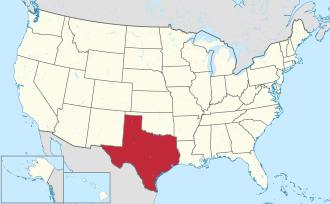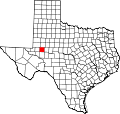Demographics
Historical population| Census | Pop. | Note | %± |
|---|
| 1890 | 1,033 | | — |
|---|
| 1900 | 1,741 | | 68.5% |
|---|
| 1910 | 3,464 | | 99.0% |
|---|
| 1920 | 2,449 | | −29.3% |
|---|
| 1930 | 8,005 | | 226.9% |
|---|
| 1940 | 11,721 | | 46.4% |
|---|
| 1950 | 25,785 | | 120.0% |
|---|
| 1960 | 67,717 | | 162.6% |
|---|
| 1970 | 65,433 | | −3.4% |
|---|
| 1980 | 82,636 | | 26.3% |
|---|
| 1990 | 106,611 | | 29.0% |
|---|
| 2000 | 116,009 | | 8.8% |
|---|
| 2010 | 136,872 | | 18.0% |
|---|
| 2020 | 169,983 | | 24.2% |
|---|
| 2024 (est.) | 183,587 | [5] | 8.0% |
|---|
|
Midland County, Texas – Racial and ethnic composition
Note: the US Census treats Hispanic/Latino as an ethnic category. This table excludes Latinos from the racial categories and assigns them to a separate category. Hispanics/Latinos may be of any race.| Race / Ethnicity (NH = Non-Hispanic) | Pop 2000 [10] | Pop 2010 [8] | Pop 2020 [9] | % 2000 | % 2010 | % 2020 |
|---|
| White alone (NH) | 72,015 | 72,822 | 76,487 | 62.08% | 53.20% | 45.00% |
| Black or African American alone (NH) | 7,940 | 8,675 | 10,465 | 6.84% | 6.34% | 6.16% |
| Native American or Alaska Native alone (NH) | 415 | 552 | 686 | 0.36% | 0.40% | 0.40% |
| Asian alone (NH) | 1,040 | 1,639 | 3,891 | 0.90% | 1.20% | 2.29% |
| Pacific Islander alone (NH) | 16 | 42 | 152 | 0.01% | 0.03% | 0.09% |
| Other race alone (NH) | 52 | 211 | 621 | 0.04% | 0.15% | 0.37% |
| Mixed race or Multiracial (NH) | 855 | 1,331 | 4,350 | 0.74% | 0.97% | 2.56% |
| Hispanic or Latino (any race) | 33,676 | 51,600 | 73,331 | 29.03% | 37.70% | 43.14% |
| Total | 116,009 | 136,872 | 169,983 | 100.00% | 100.00% | 100.00% |
As of the census [11] of 2000, there were 116,009 people, 42,745 households, and 30,947 families residing in the county. The population density was 129 people per square mile (50 people/km2). There were 48,060 housing units at an average density of 53 units per square mile (20/km2). The racial makeup of the county was 77.32% White, 6.98% Black or African American, 0.64% Native American, 0.93% Asian, 0.03% Pacific Islander, 12.17% from other races, and 1.92% from two or more races. 29.03% of the population were Hispanic or Latino of any race.
There were 42,745 households, out of which 38.90% had children under the age of 18 living with them, 57.40% were married couples living together, 11.40% had a female householder with no husband present, and 27.60% were non-families. 24.20% of all households were made up of individuals, and 8.60% had someone living alone who was 65 years of age or older. The average household size was 2.68 and the average family size was 3.21.
In the county, the population was spread out, with 30.20% under the age of 18, 8.80% from 18 to 24, 28.40% from 25 to 44, 20.90% from 45 to 64, and 11.60% who were 65 years of age or older. The median age was 34 years. For every 100 females there were 93.40 males. For every 100 females age 18 and over, there were 89.40 males.
The median income for a household in the county was $39,082, and the median income for a family was $47,269. Males had a median income of $36,924 versus $24,708 for females. The per capita income for the county was $20,369. 12.90% of the population and 10.30% of families were below the poverty line. Out of the total people living in poverty, 16.20% are under the age of 18 and 7.90% are 65 or older.
Politics
Midland County was one of the first areas of Texas to turn Republican, beginning with native son Dwight D. Eisenhower's campaign for the presidency in 1952. The last Democratic presidential candidate to win the county was Harry Truman in 1948. [14] Even in the presidential election of 1964 in which the incumbent president, Texan Democrat Lyndon B. Johnson, won a national landslide victory, it gave 57.8% of its ballots to Republican presidential candidate and Arizona native Barry Goldwater. [15] This is the last time a Democrat managed 40 percent of the county's vote, and one of only two since 1948 that a Democrat has won even 30 percent of the vote. Despite this, conservative Democrats held most local offices well into the 1980s.
Midland County is located in Texas's 11th congressional district, represented by Republican August Pfluger. The 11th Congressional District gave George W. Bush 78% of its votes in 2004, higher than any other congressional district in the nation.
This page is based on this
Wikipedia article Text is available under the
CC BY-SA 4.0 license; additional terms may apply.
Images, videos and audio are available under their respective licenses.






